Headlines and events archive
Displaying 1 - 50 of 396
You may also find an archive of news published in the media which are related with the Instituto de Astrofísica de Andalucía - CSIC.
Pages
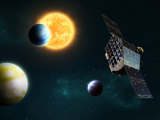
|
01/07/2025
ESA's PLATO space telescope completes key phase in its search for exoplanets The integration of the telescope’s two main components at OHB facilities in Oberpfaffenhofen (Germany) marks a decisive step for the mission The Instituto de Astrofísica de Andalucía (IAA-CSIC) plays a prominent scientific and technological role in this milestone and throughout the mission |
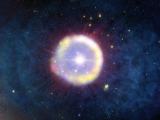
|
20/06/2025
A cosmic signal from the early universe could reveal what the first stars were like The study, published in Nature Astronomy, shows that it will be possible to determine the masses of the first stars formed after the Big Bang The Instituto de Astrofísica de Andalucía (IAA-CSIC) has analyzed how instruments like the REACH antenna and the SKA radio telescope may help reconstruct the nature of these primordial celestial bodies |

|
16/06/2025
New clues to understanding the loss of the water Mars hosted billions of years ago The study, led by the Institute of Astrophysics of Andalusia (IAA-CSIC) and published in Nature Astronomy, analyzes the role of Mars’ axial tilt in the planet’s water loss The scientific team has incorporated key improvements into the climate model used, allowing for a more accurate representation of current hydrogen escape—and therefore water loss—into space |
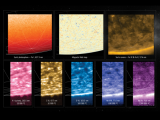
|
12/06/2025
First images of the Sun’s poles: a major milestone in solar exploration The images, captured by the Solar Orbiter mission and released this week, show the south pole of our star for the first time. The Institute of Astrophysics of Andalusia (IAA-CSIC) co-leads the mission’s largest scientific instrument (SO/PHI), which was key to this pioneering observation |
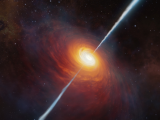
|
09/06/2025
Not all active galaxies are the same: infrared observations reveal two distinct families The work is led by Enrique Pérez Montero, researcher at the Instituto de Astrofísica de Andalucía (IAA-CSIC), who, after losing his sight in the course of his scientific career, studies the intricacies of the cosmos through sound The research focuses on the use of the infrared range to study active galaxy nucleus, considered among the most energetic objects in the universe. |

|
06/06/2025
The IAA-CSIC and the UMA sign a contract with the European Space Agency to improve Spanish space surveillance The contract is part of the National Space Surveillance and Tracking Programme (S3T) and the European Space Situational Awareness Programme (SSA) of the European Space Agency (ESA) The project aims to design a cooperative system to optimise astronomical observation for space surveillance and monitoring |
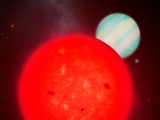
|
04/06/2025
Discovery of a giant planet around a tiny star challenges theories of planet formation The Instituto de Astrofísica de Andalucía (IAA-CSIC) participated in the discovery through key observations with the 1.5-meter telescope at the Sierra Nevada Observatory (OSN), which confirmed the existence of the giant planet The finding contradicts current theories on the formation of giant planets and opens a promising path for future research |

|
28/05/2025
Mysterious cosmic object detected emitting radio and X-ray signals synchronously The study, which reports the first detection of X-ray emission from a long-period radio transient, involves the Instituto de Astrofísica de Andalucía (IAA-CSIC) The finding, made possible by NASA’s Chandra X-ray Observatory and CSIRO’s ASKAP radio telescope, may shed new light on the origin of similar mysterious signals observed elsewhere in the sky |
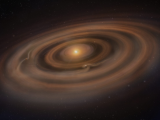
|
21/05/2025
New clues on how planet formation can mask the real properties of their star The Instituto de Astrofísica de Andalucía (IAA-CSIC) co-leads a study exploring the connection between the presence of a planet around a star and the star’s properties The study, focused on intermediate-mass stars, has revealed particularly significant results compared to what is already known about low-mass stars |
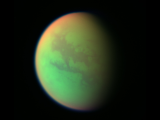
|
14/05/2025
New findings on Titan reinforce its astrobiological interest: active chemistry, clouds and methane rain Data from three instruments aboard the James Webb Space Telescope offer fresh insights into Titan’s atmosphere and chemistry—among the most complex and stable in the solar system One of the study’s key findings, involving participation from the Instituto de Astrofísica de Andalucía (IAA-CSIC), is the first direct detection of the methyl radical (CH₃) in Titan’s atmosphere, confirming major predictions about the moon’s rich organic chemistry |
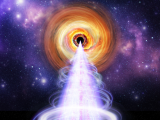
|
06/05/2025
A study led by the IAA-CSIC reveals the origin of X-ray emission in jets from supermassive black holes The research, headed by the Instituto de Astrofísica de Andalucía (IAA-CSIC), solves a longstanding mystery about the particles responsible for X-ray emission in blazars IXPE, the joint mission of NASA and the Italian Space Agency, along with the Sierra Nevada Observatory, played a key role in obtaining the data that enabled identification of the mechanism behind this extreme phenomenon |

|
03/04/2025
The James Webb Telescope reveals how stars form in one of the most extreme regions of our galaxy Two studies co-led by the Instituto de Astrofísica de Andalucía (IAA-CSIC) have examined the center of our galaxy with unprecedented detail, thanks to observations from the James Webb Space Telescope The findings could help clarify why star formation in one of the innermost regions of the Milky Way is surprisingly low despite having conditions that should favor this process |
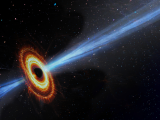
|
24/03/2025
Acceleration in supermassive black hole jets that defies theoretical predictions discovered A study co-led by the Instituto de Astrofísica de Andalucía (IAA-CSIC) reveals deviations from established models of the jets formed in supermassive black holes The finding is based on observations from the Event Horizon Telescope (EHT), whose high resolution has allowed for an unprecedented analysis of jets at close distances from supermassive black holes in the active cores of certain galaxies |
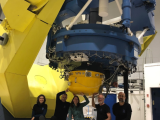
|
20/03/2025
PANIC, the first 4K infrared camera to explore the European sky The Instituto de Astrofísica de Andalucía (IAA-CSIC), together with the Max-Planck-Institut für Astronomie (MPIA) in Heidelberg, Germany, has developed PANIC, a wide-field infrared camera for the 2.2-meter telescope at the Calar Alto Observatory in Almería, Spain PANIC, which operates in the near-infrared wavelength range, will be capable of studying star clusters, galaxies, nebulae, stars, exoplanets, and even the smallest bodies in our Solar... |
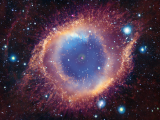
|
05/03/2025
Planet's destruction may explain mysterious X-Ray signal emitted by a dying star After decades of tracking an enigmatic X-ray signal from a star in its final life stages, this study, co-led by the Instituto de Astrofísica de Andalucía, may have finally uncovered its origin: the destruction of a nearby planet Although the Sun is currently about 4.6 billion years old and is expected to take another 5 billion years before exhausting its hydrogen and evolving into a red giant, this study explores potential fates of the planets... |
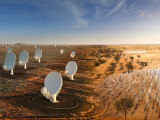
|
26/02/2025
Spain, a pioneer in the global network of SKA regional centres The Spanish prototype of the SKA Regional Centre, developed by IAA-CSIC, becomes the first centre to successfully complete its integration into SRCNet0.1, the first operational version of the international network that will form the scientific core of the Square Kilometre Array Observatory (SKAO) |
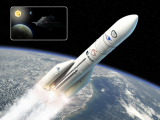
|
10/02/2025
The IAA participates in PLATO, the first scientific mission to fly aboard the new European rocket Ariane 6 On January 29, during the European Space Conference in Brussels (Belgium), the European Space Agency (ESA) signed an agreement with the space transportation company Arianespace to launch its PLATO mission at the end of 2026 The Instituto de Astrofísica de Andalucía (IAA-CSIC), a member of the PLATO Spain consortium, is participating in the mission through the development of its two main electronics units and the scientific planning prior to its... |
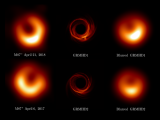
|
22/01/2025
Advances in the study of M87*: Unveiling details of the black hole's turbulent accretion flow The EHT collaboration, which includes the Instituto de Astrofísica de Andalucía, has made progress in studying the supermassive black hole M87*, located at the center of the galaxy M87 The analysis conducted by the scientific team, combining observations from 2017 and 2018, has revealed new insights into the structure and dynamics of the plasma near M87*'s event horizon |
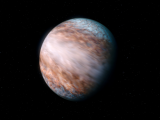
|
21/01/2025
Supersonic jet stream detected at the equator of a giant exoplanet The Instituto de Astrofísica de Andalucía is part of the international team that has identified the fastest wind ever measured on a planet, recorded in the atmosphere of the giant exoplanet WASP-127b, located more than 500 light-years from Earth This discovery, which provides unique information about extreme weather on a distant world, was achieved using the CRIRES+ instrument, installed on one of the four telescopes of the Very Large Telescope... |
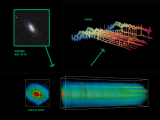
|
15/01/2025
Data sonification: a new way to study the universe A team co-led by the Instituto de Astrofísica de Andalucía has created ViewCube, an innovative tool that not only allows for the visualization of astronomical data but also enables its auditory experience This breakthrough adds a new sensory dimension to the analysis of complex data while promoting inclusion and accessibility, facilitating the active participation of people with visual impairments in the study of galaxies |
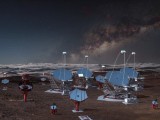
|
10/01/2025
CTAO reaches a key milestone by consolidating as a European Research Infrastructure Consortium The European Commission has established the Cherenkov Telescope Array Observatory (CTAO) as a European Research Infrastructure Consortium (ERIC), paving the way to accelerate the Observatory's construction The Instituto de Astrofísica de Andalucía (IAA-CSIC) contributes to the project by developing data analysis software for the LST telescopes, common systems for the observatory, and studying active galactic nuclei, among other... |
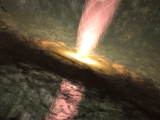
|
08/01/2025
First solid evidence of the universal mechanism shaping cosmic jets revealed An international team, including researchers from the Instituto de Astrofísica de Andalucía (IAA-CSIC), has discovered a universal mechanism that explains how jets—powerful streams of matter and energy—maintain their shape as they travel through space. This breakthrough was made possible thanks to observations from the Karl G. Jansky Very Large Array (VLA), a highly versatile radio observatory located on the San Agustin Plains, United States. |
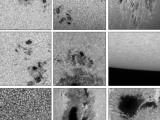
|
17/12/2024
The Sunrise III Mission captures unprecedented Solar data with exceptional spatial and temporal resolution An international scientific team, with significant Spanish participation through a consortium led by the Instituto de Astrofísica de Andalucía (IAA-CSIC), has, for the first time, obtained simultaneous data from the Sun in ultraviolet, visible, and infrared light bands. This information was gathered during the successful scientific flight of the Sunrise III mission in July 2024 |
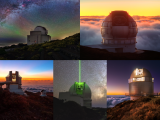
|
05/12/2024
The LPI project to explore new frontiers in quantum astronomy from La Palma The Instituto de Astrofísica de Andalucía (IAA-CSIC) is leading the LPI (La Palma Interferometer) project, aimed at conducting astronomical observations with spatial resolution a thousand times greater than that of the Hubble and James Webb space telescopes. LPI brings together the collaboration of various research centers and institutions from Spain, Italy, the Nordic countries, and Mexico, working together to establish a cutting-edge... |
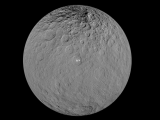
|
02/12/2024
New evidence of organic material identified on Ceres, the inner Solar System’s most water-rich object after Earth Thanks to an innovative approach combining high spatial and spectral resolution, the Instituto de Astrofísica de Andalucía (IAA-CSIC) has analyzed the distribution of organic compounds on Ceres with unprecedented detail This study paves the way for a potential future return to Ceres to clarify the nature of the detected material and examine its astrobiological implications |
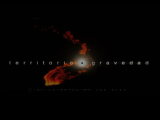
|
27/11/2024
‘Territorio gravedad’, the Spanish docu-series about the cosmos, returns with its second season The four new episodes of the series, produced by the Instituto de Astrofísica de Andalucía (IAA-CSIC), will be available from 29 November on Filmin and Vimeo On Demand |
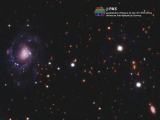
|
20/11/2024
The J-PAS Astronomical Project releases the first data from its mapping of the Universe The project, co-led by the Instituto de Astrofísica de Andalucía (IAA-CSIC), has made available to the scientific community the first twelve square degrees of the three-dimensional map of the Universe being developed from the Javalambre Astrophysical Observatory (OAJ). The studied area contains 550,000 astronomical objects and represents just a small sample of the survey's data, which aims to cover thousands of square degrees over the next... |
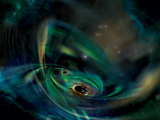
|
13/11/2024
Signal of a Binary Super Massive Black Hole System interacting with a gas cloud detected for the first time The Instituto de Astrofísica de Andalucía (IAA-CSIC) contributed to this study by providing key data obtained with its ALFOSC spectrograph, installed on the Nordic Optical Telescope (NOT) at the Roque de los Muchachos Observatory in La Palma. This information complements data from NASA’s Neil Gehrels Swift Observatory and the ZTF project. |
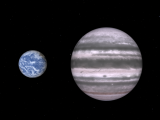
|
31/10/2024
Several Neptune-like planets discovered in a theoretically barren region The study, focusing on the planetary nature of thirteen objects of interest from the TESS mission, confirms the existence of five new planets around red dwarf or M-type stars, which are smaller and cooler than our Sun. The planets lie within or very near the "Neptunian desert," a region noted for the scarcity of planets with characteristics similar to those of Neptune. |
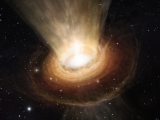
|
15/10/2024
Supermassive black holes alter the chemical evolution of galaxies The IAA-CSIC participates in this study that shows how the activity of a supermassive black hole hidden in the heart of a quasar has transformed the chemical composition of the gas in the galaxy. |

|
05/09/2024
IAA-CSIC researcher Rafael Luque receives a ‘Starting Grant’ from the European Research Council The grant, 1.5 million euros over the next five years, will help to understand the properties of subneptune-type planets. |
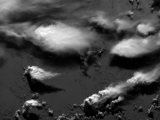
|
23/08/2024
JANUS, the optical camera on ESA's JUICE probe, captures stunning images during its first lunar and terrestrial flyby JANUS, the optical camera on ESA's JUICE probe, captures stunning images during its first lunar and terrestrial flyby |

|
07/08/2024
Origin of persistent emission in enigmatic Fast Radio Bursts revealed A new international study involving the IAA-CSIC identifies a plasma bubble as the origin of the persistent emission observed in some fast radio bursts (FRBs) The data also allow researchers to determine the nature of the "engine" that powers these mysterious sources The results are published today in Nature |
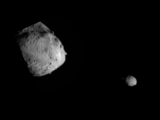
|
30/07/2024
NASA's DART mission captures high-resolution image of the binary asteroid system Didymos The study, which analyzes the geology and origin of this binary asteroid system close to Earth, concludes that the surface of Didymos is between 40 and 130 times older than its satellite Dimorphos The work has been published in five articles in Nature Communications and the IAA-CSIC participates in one of them |
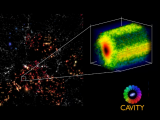
|
15/07/2024
The IAA-CSIC participates in a project that offers the scientific community three-dimensional images of 100 galaxies CAVITY is the name of this international initiative whose objective is to monitor up to 400 galaxies in the future to learn about their formation and evolution The material is now available through the website www.cavity.caha.es |
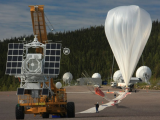
|
10/07/2024
Sunrise III successfully launched This mission has a strong participation of the Solar Physics Group of the IAA. |
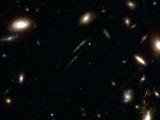
|
24/06/2024
The most distant and oldest star clusters discovered The James Webb Space Telescope observes star clusters in a galaxy just 460 million years after the Big Bang. The Instituto de Astrofísica de Andalucía (IAA-CSIC) and the Instituto de Física de Cantabria (IFCA-CSIC-UC) are participating in this discovery. |
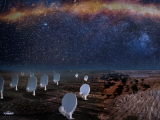
|
21/06/2024
The IAA strengthens CSIC's international role in the SKA Observatory The IAA has been endowed by the CSIC with nearly one hundred thousand euros to strengthen the capacities of the scientific community that will use SKAO through the Spanish SKA Regional Centre. "CSIC4SKA", led by the IAA-CSIC, was one of five projects funded under the CSIC Programme for Large European Research Infrastructures. |
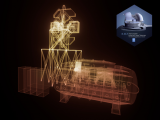
|
05/06/2024
ANDES instrument for the European Giant Telescope ELT is agreed upon The Instituto de Astrofísica de Andalucía (IAA-CSIC) participates in both its technological development and its scientific objectives. |
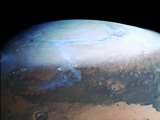
|
28/05/2024
It snows more on Mars than expected Researchers from IAA-CSIC lead a new method to measure carbon dioxide snow and frost variations on Mars surface. The initial results indicate that the deposited snow thickness is up to two orders of magnitude greater than estimated. |
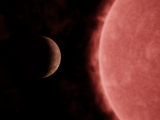
|
15/05/2024
Earth-type planet found in an ultra-cool dwarf star IAA-CSIC researchers participate in the discovery of one of the few known planetary systems in this type of stars The results, published today in Nature Astronomy, have been contributed by the Sierra Nevada and Calar Alto observatories |

|
14/05/2024
Giant planet as light as cotton candy discovered The Instituto de Astrofísica de Andalucía (IAA-CSIC) is co-leading the study of the second lightest planet discovered to date. |
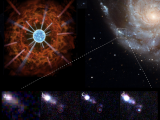
|
27/03/2024
Newly collapsed red supergiant star spotted Explosion of a supergiant star detected just one hour after its collapse. Amateur observatories have been key in detecting the supernova in its initial phases. The IAA-CSIC participates in this study published in Nature through its global network of robotic telescopes BOOTES. |
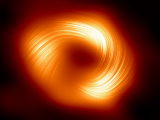
|
27/03/2024
Astronomers Unveil Strong Magnetic Fields Spiraling at the Edge of Milky Way’s Central Black Hole A new image from the Event Horizon Telescope (EHT) collaboration has uncovered strong and organized magnetic fields spiraling from the edge of the supermassive black hole Sagittarius A* (Sgr A*). |
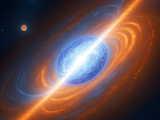
|
21/02/2024
First observation of the formation of 'rare earths' following the merger of two neutron stars A study involving the Instituto de Astrofísica de Andalucía (IAA-CSIC) shows a kilonova as a source of heavy elements, including the precious 'rare earths'. The work, published in Nature, highlights this type of explosive and extremely energetic phenomena as the ideal environment for the formation of metals heavier than iron and silver. |
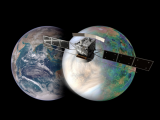
|
06/02/2024
The European Space Agency approves construction of EnVision, the next major mission to Venus The Instituto de Astrofísica de Andalucía (IAA-CSIC) participates in both its technological development and its scientific return. The mission will study Venus's core and atmosphere to understand its volcanic activity and climate and find out how this twin of Earth became so inhospitable. |
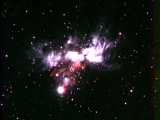
|
29/01/2024
The AFGL 5180 region, cradle of giant forming stars, reveals its secrets in the infrared The Instituto de Astrofísica de Andalucía (IAA-CSIC) leads a study that reveals, in unprecedented detail, a region of massive star formation |
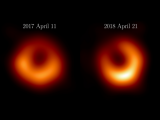
|
18/01/2024
M87* One Year Later: Proof of a persistent black hole shadow The Instituto de Astrofísica de Andalucía (IAA-CSIC) participates in the international collaboration that confirms the existence of a bright ring corresponding to the shadow of the black hole in the Messier 87 galaxy. The stability of the diameter of the ring with respect to the data obtained in 2017 supports the conclusion that the black hole M87 is correctly described by the theory of general relativity. |
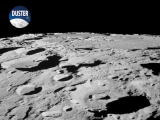
|
15/01/2024
Project DUSTER: a study of lunar dust in preparation for future exploration missions As space agencies prepare to return to the Moon, scientific and engineering teams face the challenge of mitigating a major environmental risk: dust The Institute of Astrophysics of Andalusia (IAA-CSIC) participates in the DUSTER project, which will study charged dust particles, which pose a serious risk to the health of human explorers and space instruments |
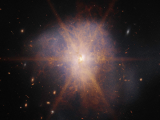
|
08/01/2024
Galaxies caught in the throes of chemical 'rejuvenation' An IAA-CSIC team leads a pioneering study that reveals the crucial role of galactic mergers in the chemical evolution of Ultraluminous Infrared Galaxies. |